

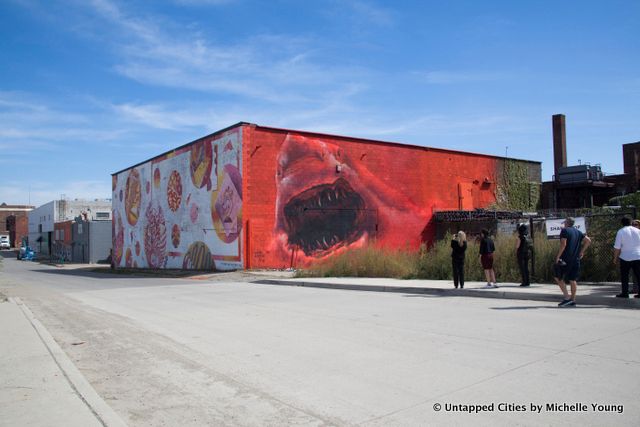
Murals in the Market at Eastern Market
What is it that we leave behind? In Detroit during the 2015 Design Festival, I thought about this a lot. I landed and witnessed a new Detroit before me – one I had not seen in the 30+ years I had known it or in the last 5 years of its supposed rebirth. Then a few hours later, I learned that my friend, the immensely talented filmmaker Nick Louvel, director of the new documentary The Uncondemned and the Edward R. Murrow Award-winning Haiti: Where Did the Money Go, was killed in a car crash in New York, on a trip back from hand delivering his award-winning film to the Hamptons International Film Festival. Though Nick’s life was cut tragically short, his legacy is clear – a dedication to cinematic works that investigate the hard questions – works that will stand the test of time. As I struggled to comprehend a personal tragedy, it allowed me to see that this question of legacy is also playing out here, at a city level in Detroit.
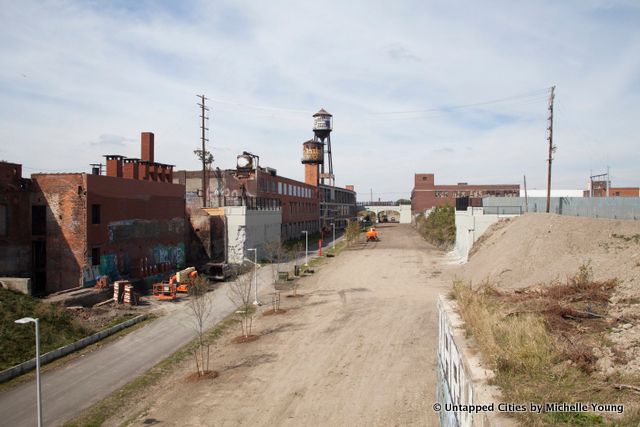
Construction on the new section of the Dequindre Cut
It’s a city whose people are delineating what the legacy of Detroit will be, what will be left behind when they themselves are gone. This question is especially important for a place originally built on physical manifestations of grandeur – the City Beautiful, the radiant city, the eternal city – and the harsh reality of its impermanence. It’s a city that has moved past its celebration as a ruined, fallen masterpiece. And a city that has also emerged past the first, loud hype of rebirth.
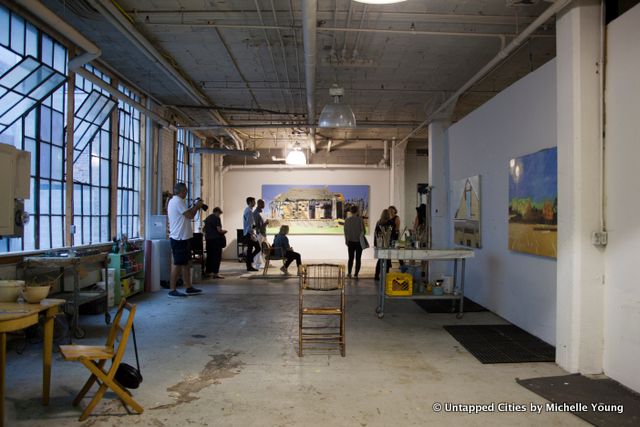
Studio of painter Nancy Mitchnick in the Russell Industrial Center
One major sign has been the return of expatriates, natives of Detroit who once left for greener pastures. One gets the distinct sense, through their verbal personification of the city, that the Detroit of old had failed them, like a parent or friend who has let them down. In her studio at the Russell Industrial Center, painter Nancy Mitchnick and former professor at Harvard University, tells us that after all this time, Detroit finally has something for her. Nancy has been systemically painting abandoned houses–both on them and representing them on canvas, achieving the most critical success of her career thus far. Gary Wasserman, president of Allied Metals and founder of the Wasserman Projects, tells me that he once felt “the misfortune of being from Detroit.” He left the city for 15 years but returned when the time was right with a renewed mission.
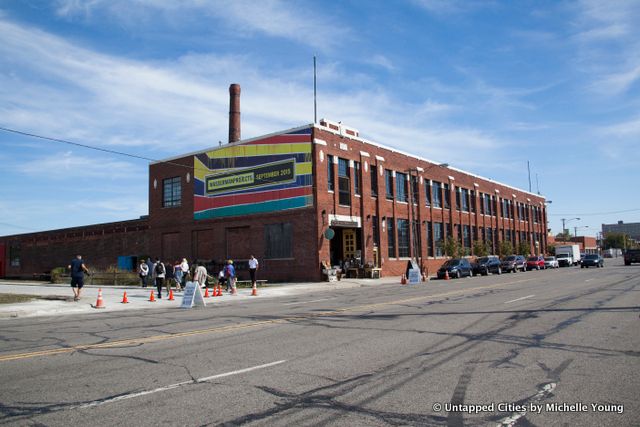
The Wasserman Projects at Eastern Market
Such prodigal returns can only be explained through the promise of possibility. There is a distinct sense that something entirely new can be created here, a laboratory and model for a future city that can redeem the mishaps of the old. As Wasserman says, it is an “organic evolution of a new urban experience…something that is yet to be determined that will unfold in its own way.” Wasserman sees the Wasserman Projects, a multi-disciplinary art and design space he co-founded with Charlie Kashner that opened this past Friday in Eastern Market, as just one “thread in the fabric” of a multi-faceted effort taking place.
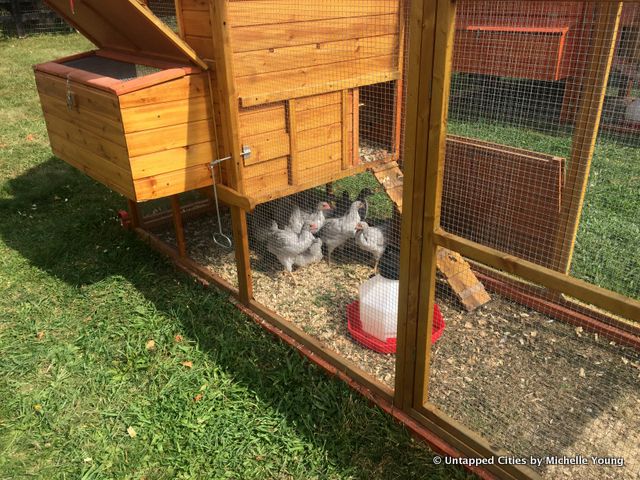
Chickens to be cross-bred in the future for the Cosmopolitan Chicken Project
This means that newer arrivals are adding to the conversation and becoming an integral part of the narrative, too. Belgian conceptual artist Koen Vanmechelen, whose Cosmopolitan Chicken Project, will be part of the Wasserman Project installations next year, tells me that what he looks for is authenticity, and that’s precisely why he will permanently extend his endeavor, based in Belgium and currently exhibiting at the Venice Biennale, to Detroit.
Vanmechelen cross-breeds chickens from around the world as a metaphor for what he sees as a better humanity – that mixing leads to more vitality, diversity, immunity and fertility. Evolution, by necessity, requires crossing and the chicken is his symbol, the egg his tool. It has “nothing to do with chickens and everything do with societies,” he says. The Detroit version of the Cosmopolitan Chicken Project will include a breeding space and an egg and mushroom production facility, rooted in engagement among the larger Detroit community.
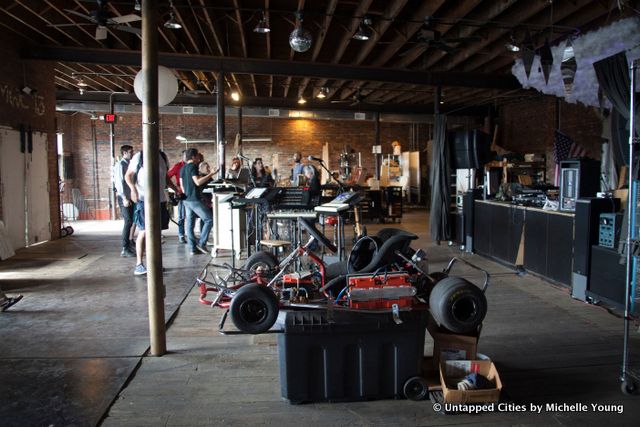 Inside Omnicorp Detroit
Inside Omnicorp Detroit
Approaching diversity with a more literal approach, Jeff Sturges of the hackerspace Omnicorp Detroit, which we covered in 2013, relocated from New York (and before that Cambridge, Massachusetts) to Detroit in 2010. Omnicorp has evolved from a makerspace into a dynamic co-working, creative space. Sturges’ work is physically the centerpiece of Omincorp, an electronic music lab and DJ booth, in the middle of a loft-like manufacturing space in Eastern Market. Here, coders, textile designers, eyewear designers, engineers, urban planners and artists work and share their ideas.
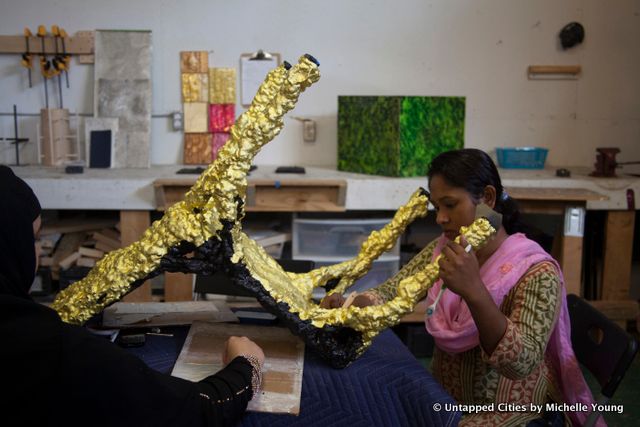
Studio of Chris Schanck
Indeed, there is something greater in Detroit happening than simply the bottom line. As artist Chris Schanck, a Texan by way of New York City, tells us in his studio in Hamtramck while his team was putting together avant-garde furniture for Christian Dior stores, the “context of Detroit is so powerful, the pressure is so strong you have to react.” He explains that the art scene in Detroit evolved despite a “complete absence of a market…How does an art community persist without a market? Take away market motivation and art starts to develop in other ways.” The art comes from the pure physicality of Detroit versus an intellectualism you may find in other cities, and the result is a community that Schanck sees as resilient and collaborative. Still, Schanck says, in Detroit, “you can’t just be smart, you have to be strong.”
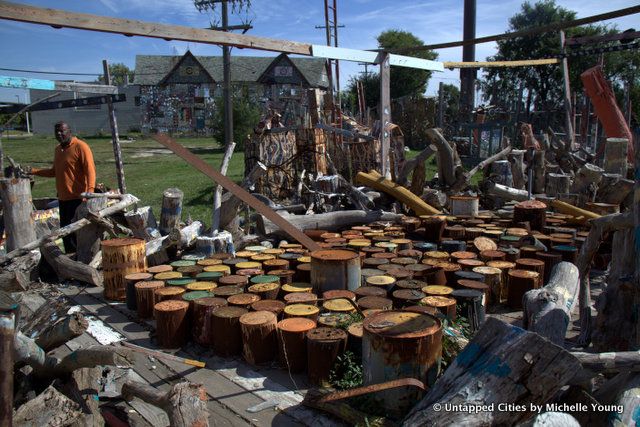
That strength and consistency of effort is seen clearly at the MBAD African Bead Museum, a sprawling, outdoor exhibit of found and donated objects, entitled “Iron Teaching Rocks to Rust” has been built by Olayami Dabls over the course of 20 years. The metaphor of cultural colonialization and assimilation explored here is as relevant today as it was decades ago, if not centuries ago.
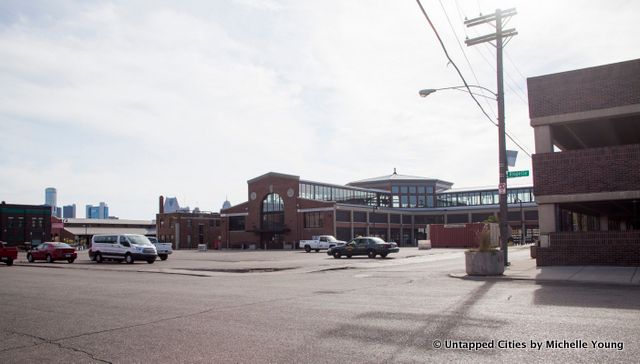
Eastern Market is one of the current laboratories of all these ideas in Detroit, anchored already by places like Omincorp, art galleries, and now Wasserman Projects. The Eastern Market Corporation hopes to maintain its historic food identity while attracting a new creative class. As Daniel Carmody, president of the corporation tells us, the organization hopes to keep the authenticity of the working food district, while reconfiguring it. The public market, the oldest and largest produce market left in the United States, will be relocated to newer buildings nearbywhile the older structures will be freed up for housing and the arts.
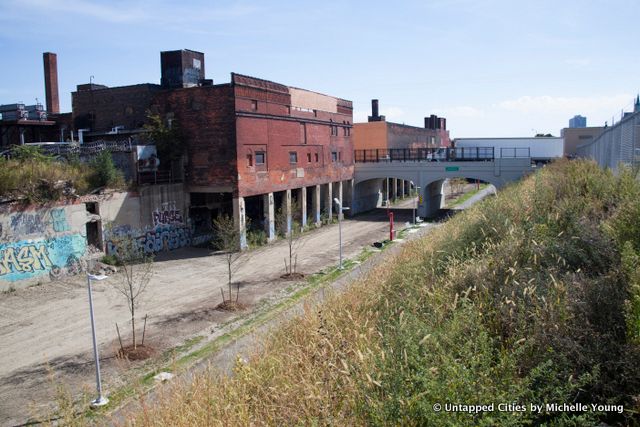
The Dequidnre Cut
The corporation has been acquiring properties in the area to offer below market rate, setting ordinances against the influx of chain brands, supporting owner occupied, local businesses, and setting up what’s necessary to serve a neighborhood that sees upwards of 50 to 60% unemployment rates. Meanwhile, under construction below grade is an extension of the Dequindre Cut (aka “The Cut”), Detroit’s answer to the High Line/Low Line phenomenon. Run by the Detroit Riverfront Conservancy, The Cut is built out of the former Grand Trunk Railroad line.
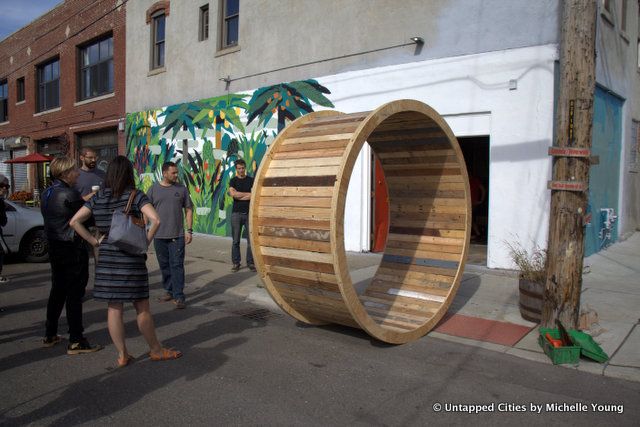
In front of Omnicorp, preparing for Red Bull Creation
Also palpable in Detroit, particularly around the Eastern Market area is the institutionalization of the street art scene in Detroit. Murals in the Market, an initiative by 1xRUN and the Inner State Gallery invited street artists from all around the world to establish a visual identity to an area well on its way to developing a strong sense of place on the social-cultural stage. Along The Cut are more street art murals, commissioned by The Detroit Riverfront Conservancy.
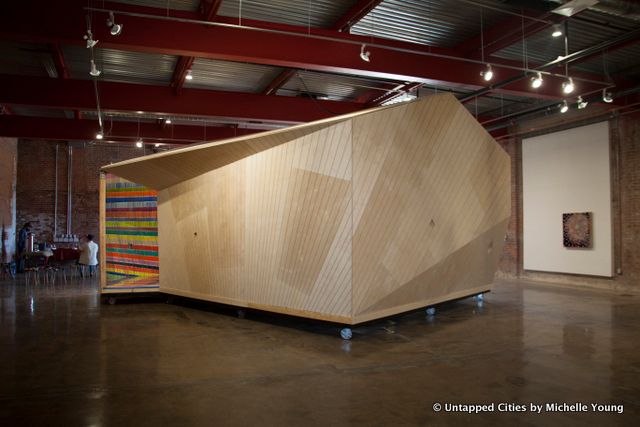
THEFIRSTONEISCRAZYTHESECONDONEISNUTS in Wasserman Projects
The opening of Wasserman Projects provided a glimpse of what a future might look like in Detroit. Sleek, polished productions that are nonetheless cognizant of history, the community, and the fragile role each organization plays in the evolution of the city. Several attendees expressed that they had never been to an event quite like this in Detroit before. There was a confluence of old and new, a meeting of influences from outside Detroit and bubbling up from within, and again, that sense of possibility.
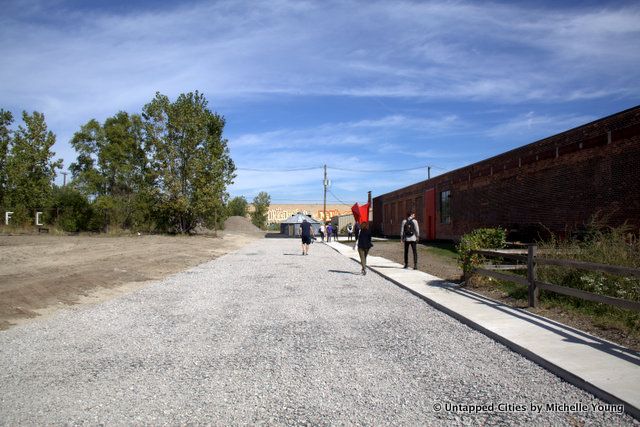
Wasserman Projects
Inside Wasserman Projects, a site specific work entitled “THEFIRSTONEISCRAZYTHESECONDONEISNUTS” is a pavilion designed by architect Nick Gelpi and painted by German born, Brooklyn-based artist Markus Linnenbrink in his signature, colorful style. The pavilion splits open to become a performance venue, inside which the group New Music Detroit gave us a sampling of what the collective is cooking up. Above on an alcove, Detroit DJ Jeedo X was spinning, and saxophonist Saxappeal played amongst the revelers.
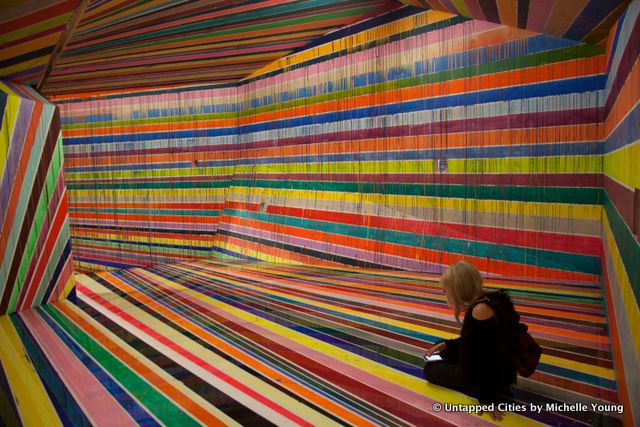
Outside and inside, Detroit-based artist Jon Brumit has a series of sound installations. One, a grain silo which converts music from your iPhone into guttural, mechanical noises. Another, an exhibit of lathe-cut records looping amidst fake food.
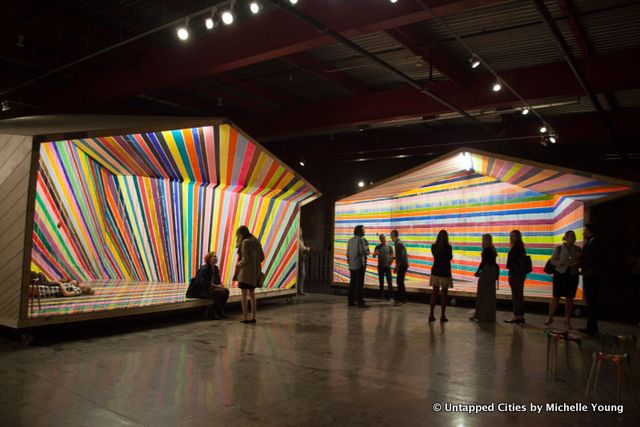
As Wasserman likes to say, “Detroit is not the only city to fail, it is the largest one.” Certainly, there is much still more to address in Detroit and many more areas to approach with new ideas. Eastern Market is just one experiment in this laboratory of what to do with failed cities, but it is one rooted in economic policy, and for now, the prognosis is hopeful.
Get in touch with the author @untappedmich. Next, see photos inside the abandoned Michigan Central Station.


